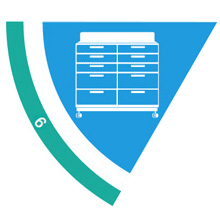
When we talk about disinfection, we talk about the prevention and control of infection in the environment. Therefore, equipment used for respiratory therapy is considered semi-critical. The equipment must then be cleaned and disinfected properly between patients. The WHO gives us the proper maintenance of respiratory equipment in procedures to follow. The procedures are checklists in steps of a cycle. Let’s explore all the summarized steps up to the cycle finish. And yes, the cleaning step is before the disinfection step!

1. Perform hand hygiene

The title and image say it all
2. Don appropriate personal protective equipment

The personal protective equipment to be worn during the disinfectant preparation includes surgical mask/respirator, googles/face shield, long-sleeved fluid resistant gown/gown plus apron, rubber gloves and boots or closed work shoes.
3. Wash with detergent and rinse with clean water

The external device surfaces must be wiped with a damp cloth or disposable wipe that is soaked in detergent and clean water. Then, remaining detergent residue must be wiped off with a dry lint-free cloth. A mechanical action (scrubbing/brushing) should be used to remove visible dirt deposits and calcifications.
4. Disinfect

4a. Physical disinfection – Heat for heat resistant equipement (steam/hot-water)
A high-level of physical disinfection can be achieved with steam (e.g. autoclaving at lower temperature) or hot-water at least 121°C. This is an inexpensive and effective method for sterilization or high-level disinfection.
4b. Chemical disinfection for plastic plus other parts that can be damaged by heat
b) If the disinfection needs to be with chemicals solutions, it should be performed in a well-ventilated area and away from patients. Use a disposable wipe or a fresh cloth that is soaked in a compatible disinfectant. Hydrogen peroxide 0.5% or ethanol 70-90%. Wipe from top to bottom and avoid contact with electrical connectors.
5. Dry equipment / Rinse equipment

a) Physical equipment often has a drying feature within the machine (e.g. washer, pasteurizer or autoclave). Following pasteurization, the wet equipment is typically dried in a hot-air drying cabinet or air-dried. Make sure to carefully inspect and ensure that no water is left in the equipment.
b) If a chemical solution was used for disinfection, rinse the equipment with sterile or clean water (i.e. water boiled for 5 mins and cooled down). It is preferred to use sterile water for rinsing off residual liquid chemical disinfectant from the respiratory device.
6. Store equipment in closed packages

Last step. Title says it all.
This was a summary of the Care, cleaning and disinfection of respiratory equipment in sterile services department’s article by World Health Organization.
This article is a free translation of WHO’s article.
Source:
World Health Organization
– https://www.who.int/publications/m/item/care-cleaning-and-disinfection-of-respiratory-equipment-in-sterile-services-department
– https://www.who.int/images/default-source/health-topics/coronavirus/care-cleaning-disinfection-of-respiratory-equipment.tmb-479v.png?sfvrsn=14530f0b_1